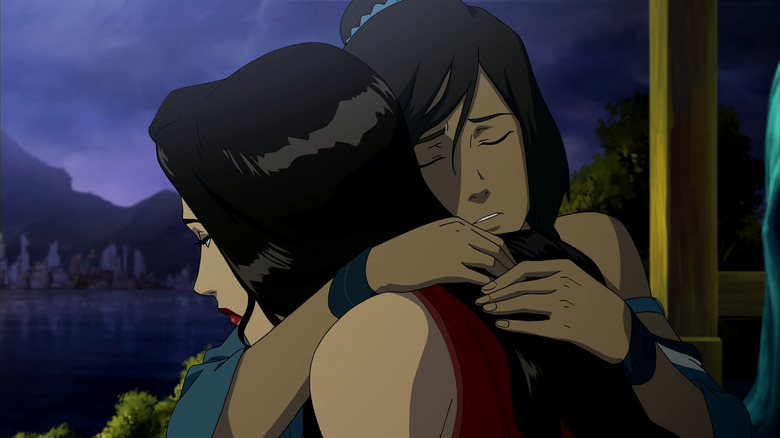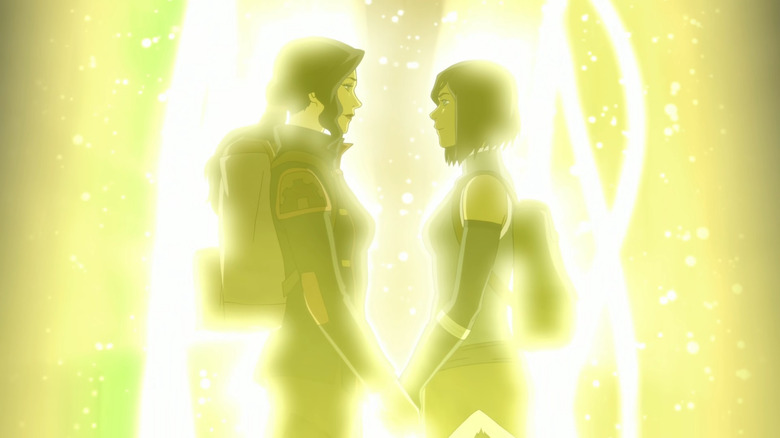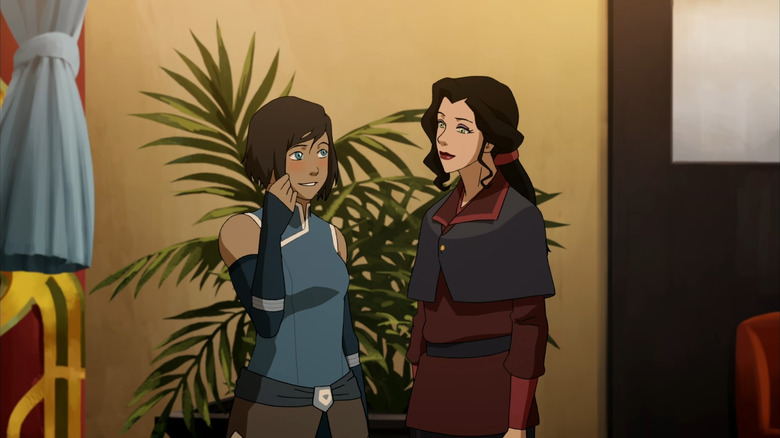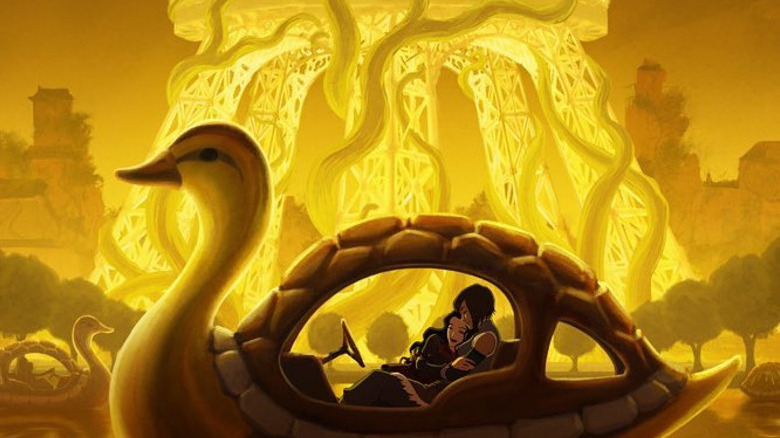Who Does Korra End Up With & Why Was It So Controversial For Avatar Fans?
"The Legend of Korra" was an anomaly in many ways during its four-year run on Nickelodeon. While it took place in the timeline of "Avatar: The Last Airbender," which had been a massive hit for the network, "Korra" was more young-adult angled in its characters, narrative, and themes. As it went on, it became increasingly clear that Nick had no idea what to do with a show that was so different from its regular programming. The series was moved from Saturday mornings to Friday nights after a murder-suicide scene at the end of Season 1, and much of the last two seasons aired online rather than on TV, despite the show earning widespread critical acclaim throughout its run.
In many ways, the series was ahead of its time, and that extended to its willingness to portray queerness on-screen. In the years after, cartoons like "Steven Universe," "She-Ra and the Princesses of Power," and "The Owl House" made major strides forward in portraying all kinds of people and relationships in children's media, but they couldn't have run if earlier shows like "Korra" hadn't walked first.
And yet, while "The Legend of Korra" is well known for its boundary-pushing finale, the series wasn't allowed to ever be explicit with its two leading LGBTQ+ characters. The end of the show was received by some as an out-of-nowhere appeal to niche fan service, but in reality, it was a bold culmination of series-long storylines that played perfectly into the arcs of the characters.
The Legend of Korra's ending, explained
On the early seasons of "The Legend of Korra," the romance storylines center on a love triangle between Mako, Korra, and Asami. Mako dates both women at different times, but by Season 3, they're all just friends, and Korra and Asami start to spend a lot more time together one-on-one on-screen. A multi-year time jump between Seasons 3 and 4 covers Korra's extended recovery from a major injury and accompanying trauma, during which time she chooses only to exchange letters with Asami. "It's easier to tell you about this stuff," she says. When they finally reunite midway through the season, Asami is quite taken with Korra's new haircut, drawing a bashful reaction.
If you were on tumblr or forum threads while Season 4 was airing, this all read pretty clearly to you. The "Korrasami" ship had been a thing in the fandom from very early on, and it was apparent that the writers were dropping intentional hints that it might become real. The question then became whether or not Nickelodeon would allow an actual queer relationship, or if like so many shows before, there'd only be vague suggestions.
The ending of "The Legend of Korra" splits the difference a bit. After defeating the season's main villain and saving Republic City, Korra and Asami share a quiet moment of reflection. They then walk into the city's newly minted Spirit World portal together and clasp hands while staring longingly into each other's eyes. The message was clear, but because there was no kiss, many "fans" still declared the scene was meant to be ambiguous.
Who does Korra end up with & why was it so controversial?
"The Legend of Korra" faced major backlash for its final scene with Korra and Asami. As still happens today with shows like "The Lord of the Rings: The Rings of Power" or "Star Wars: The Acolyte," bigotry from certain sects of the fandom was veiled as a criticism of "bad writing," with fingers pointed at a relationship some claimed to have come out of left field at the last minute. Though the modern right-wing campaign against "woke" media hadn't yet taken shape, the modus operandi was the same. Some viewers even claimed that due to the ending's ambiguous nature, it was just as valid to view the two characters as good friends rather than lovers. Fortunately, the show's creators quickly spoke out to put those ideas to bed.
"Korrasami is canon," series co-creator Bryan Konietzko wrote in a tumblr post shortly after the finale aired. "You can celebrate it, embrace it, accept it, get over it, or whatever you feel the need to do, but there is no denying it. That is the official story." While the idea of getting the two characters together arose much earlier on, the writers were aware of the limitations that came with being a Nickelodeon show — even one of the best ones. "The more Korra and Asami's relationship progressed, the more the idea of a romance between them organically blossomed for us," Konietzko wrote. "However, we still operated under this notion, another 'unwritten rule,' that we would not be allowed to depict that in our show."
While the series itself was only allowed to heavily imply the relationship, the canonical comics that came after were allowed to be much more clear.
What happens to Korra and Asami after the end of the show?
In the three-part comic "Turf Wars," which takes place immediately after "The Legend of Korra" Season 4, Korra and Asami embark on a vacation of sorts in the Spirit World. They kiss, discuss their sexualities, and consider how other people in their lives will react to their relationship. The comic also explores how the different nations of the "Avatar" world view queerness differently. It's an interesting exploration of the various cultures that also leaves room for Korra and Asami to figure out their own individual relationship.
Later comics show how the two balance Korra's Avatar responsibilities with Asami's career as an inventor and businesswoman. Other characters like Mako, Bolin, and Korra's parents also get to celebrate their love. In addition to the comics, Bryan Konietzko released an original art piece on tumblr showing the two women on a "Turtle-duck Date Night" in Republic City, which you can see above.
While the two characters just make a lot of sense together, and you can leave it at that, their relationship also fits quite well with their larger character arcs. Korra's story is largely one about not fitting into a role put upon her by the world. The job of the Avatar has changed with the modern times of her era, but she still struggles to figure out how to be herself and trust her own choices. Asami, similarly, grapples with a challenging family legacy. It isn't until they both can fully embrace their true selves that their relationship can flourish.
"I love how their relationship arc took its time, through kindness and caring," Konietzko wrote in his original tumblr post. "If it seems out of the blue to you, I think a second viewing of the last two seasons would show that perhaps you were looking at it only through a hetero lens."



